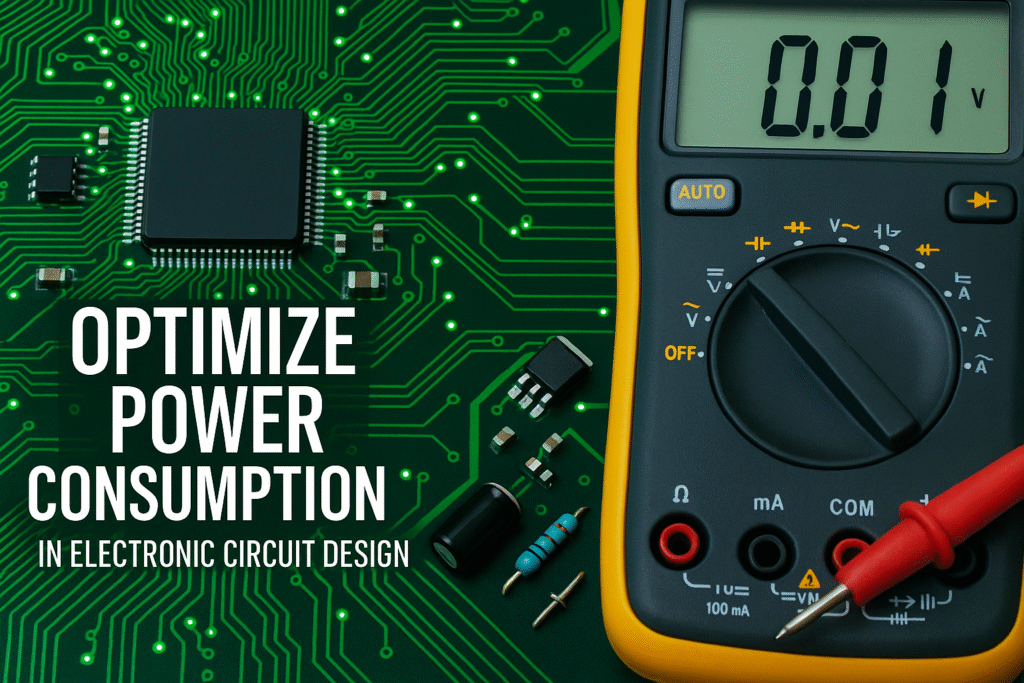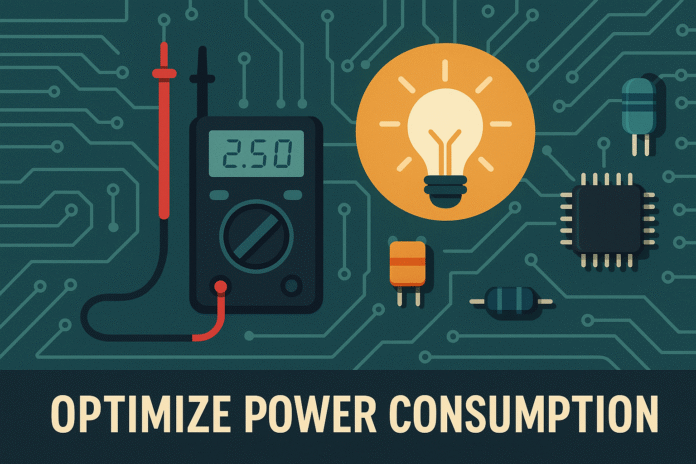Reducing power consumption is one of the top priorities in modern electronic circuit design. From wearable devices to industrial automation systems, power efficiency translates into better performance, longer battery life, lower heat generation, and reduced environmental impact. Whether you are developing portable consumer gadgets or complex embedded systems, knowing how to optimize power consumption in electronic circuit design is essential.
A well-planned approach starts at the earliest design phases, particularly during pcb design, where trace layout, power planes, and component placement can significantly influence current flow and energy efficiency. In this article, we examine practical strategies, tools, and design choices that help engineers reduce power usage at both the hardware and system levels.
How to Reduce Power Consumption in a Circuit?
Reducing power in electronic circuits involves a mix of component selection, architectural decisions, and layout optimization. The following methods are commonly used to minimize power drain:
1. Use Low-Power Components
Select ICs, sensors, and microcontrollers (MCUs) that support ultra-low-power operation. Many components today come with power-saving modes such as shutdown, sleep, and standby. Choosing MCUs with efficient sleep currents and wake-up mechanisms is vital for battery-powered applications.
2. Power Gating
Power gating disconnects power to parts of the circuit that are not in use. This can be implemented at the system-on-chip (SoC) level or in discrete designs using load switches or MOSFETs. The technique conserves energy by reducing leakage and dynamic power when specific blocks are idle.
3. Dynamic Voltage and Frequency Scaling (DVFS)
DVFS adjusts the supply voltage and clock frequency of the processor based on workload. By reducing clock speed and voltage when full performance is not needed, power is saved without impacting overall functionality. DVFS is commonly implemented in embedded Linux and RTOS-based systems.
4. Duty Cycling
Instead of running continuously, circuits are activated only when needed. This is especially useful in sensor networks where data is collected periodically. Wake-on-event strategies, where interrupts trigger processing, keep circuits asleep for most of the time.
5. Minimize Signal Switching
Switching activity is a major contributor to power loss. By optimizing logic to minimize transitions, dynamic power is reduced. Techniques such as clock gating help stop the clock in unused flip-flops and sequential logic, cutting unnecessary toggling.
6. Optimize Load Capacitance
Reducing capacitive loading on outputs leads to lower dynamic power. Keeping trace lengths short and using buffers only where necessary also contributes to energy savings.
Which Technique Is Used to Reduce Power Consumption in VLSI Circuits?
In VLSI (Very-Large-Scale Integration) design, the challenge of power reduction is magnified due to the high density of transistors and operating speeds. Power optimization here requires a multi-layered approach:
1. Multi-Threshold CMOS (MTCMOS)
This technique uses transistors with different threshold voltages. High-threshold devices are used for power-sensitive areas, while low-threshold transistors are applied where speed is more important. During idle states, high-Vt devices help reduce leakage power.
2. Power-Aware Synthesis
Synthesis tools in VLSI can be configured to prioritize power optimization, generating RTL (Register Transfer Level) code with fewer transitions and better resource sharing.
3. Clock Gating at RTL
Clock gating adds control logic to disable the clock signal to unused modules. This reduces dynamic power by preventing unnecessary switching in sequential circuits.
4. Body Biasing
Adjusting the voltage between the body and source of a MOSFET can influence the threshold voltage and reduce leakage current. This dynamic control helps minimize standby power.
5. Hierarchical Power Domains
Dividing a chip into multiple power domains allows individual blocks to be turned off or put into retention mode, improving energy efficiency in SoCs.
6. Use of FinFET Technology
Fin Field-Effect Transistors (FinFETs) offer reduced leakage and better control over short-channel effects, making them suitable for low-power VLSI designs.

How to Make a Circuit More Efficient?
Efficiency in circuit design isn’t just about reducing power—it’s about doing more with less. The following best practices enhance circuit efficiency:
1. Accurate Load Estimation
Analyze the current and voltage requirements of each block to avoid over-design. Overestimating current leads to oversized regulators and wasted power.
2. Use Switching Regulators Instead of Linear
While linear regulators are simpler, they waste excess voltage as heat. Switching regulators (buck, boost, buck-boost) operate at higher efficiency, especially when the input voltage is significantly above or below the load voltage.
3. Efficient PCB Design
Good pcb design plays a crucial role in power optimization. Wide traces reduce resistance and power loss. Proper placement of decoupling capacitors reduces voltage dips and EMI. Star grounding and solid ground planes help maintain stable power delivery.
4. Minimize Quiescent Current
Select voltage regulators and analog components with low quiescent current. This is particularly important in systems that remain idle for long periods.
5. Optimize Software and Firmware
Code running on microcontrollers should be written to enter low-power modes as often as possible. Avoid polling loops and prefer interrupt-driven architectures.
6. Use Energy-Efficient Communication Protocols
In wireless circuits, select low-power communication protocols like BLE (Bluetooth Low Energy), Zigbee, or LoRa for applications that don’t require high throughput.
What Device Is Used to Control Power in a Circuit?
Controlling power at different parts of a circuit allows designers to turn off or adjust power dynamically. The most commonly used devices include:
1. MOSFETs and Load Switches
MOSFETs act as efficient electronic switches. With appropriate gate control, they can selectively power on or isolate parts of a circuit. Load switches are integrated versions optimized for low on-resistance and fast switching.
2. Power Management ICs (PMICs)
These integrated solutions include multiple regulators, power sequencing, and fault protection in one chip. They manage power rails in complex SoC-based systems.
3. Voltage Regulators (LDO and Switching)
Used to provide stable voltage, some advanced regulators support programmable output levels and sleep modes.
4. Supervisors and Power Sequencers
These ensure that voltage rails are powered up and down in a specific order, especially important in FPGAs and SoCs to avoid latch-up or configuration failures.
How Can We Reduce Power Consumption in Digital CMOS Circuits?
CMOS circuits are known for low static power, but dynamic switching can consume considerable energy. Here’s how to reduce that:
1. Reduce Supply Voltage (VDD)
Dynamic power is proportional to the square of VDD. Reducing voltage levels has a big impact but must be balanced against timing constraints.
2. Decrease Clock Frequency
Lowering the clock frequency reduces switching events and allows for lower voltages.
3. Use Clock Gating and Operand Isolation
Prevent unnecessary transitions by gating the clock or isolating operands in combinational blocks when not needed.
4. Reduce Capacitance on Nodes
Keep interconnect lengths short, reduce fan-out, and avoid large gates that load output heavily.
5. Use Asynchronous Design
Where feasible, eliminate the global clock and use asynchronous logic. This approach avoids clock tree power but introduces design challenges.
6. Hierarchical Power Management
Group logic blocks by function and isolate them during idle times. Power islands can be managed using on-chip control logic or external PMICs.
How to Reduce Energy Loss in a Circuit?
Energy loss manifests as heat, electromagnetic emissions, or inefficient power conversion. Strategies to minimize it include:
1. Optimize Power Conversion Efficiency
Design DC-DC converters for operation near their peak efficiency curve. Minimize switching and conduction losses.
2. Use Efficient Signal Transmission
High-speed signal lines should use controlled impedance traces. Differential pairs and proper termination reduce reflection and radiation.
3. Avoid Voltage Droop and Overshoot
Decoupling capacitors placed near power pins absorb transients. Soft-start features in regulators avoid inrush currents.
4. Thermal Management
Lower power also means lower heat, but proper thermal vias, heat sinks, and copper pours help dissipate what remains. Thermal-aware layout prevents hotspots that could lead to degradation or failure.
5. Optimize Load Matching in RF Circuits
Impedance mismatches lead to signal reflections and wasted energy. Use matching networks to ensure maximum power transfer in antennas and filters.
6. Reduce Leakage Paths
In both analog and digital domains, leakage currents through unconnected inputs or reverse-biased junctions can be reduced with pulldown resistors and careful biasing.
Industry Applications of Low-Power Circuit Design
Designing for low power is essential in:
- Wearables: Battery-operated devices with long lifespans.
- Medical Devices: Implants and monitors requiring ultra-low standby power.
- Industrial Sensors: Harsh environment nodes powered by batteries or energy harvesting.
- IoT Gateways: Balance between processing and energy autonomy.
- Aerospace: Mission-critical systems where overheating is unacceptable.
Simulation and Validation Tools
Engineers rely on simulation to validate power consumption before prototyping:
- SPICE: Transistor-level simulation for analog power analysis.
- Power-aware RTL Tools: For VLSI and FPGA power estimation.
- EMI Simulation: Predict radiation hotspots and trace resonances.
- Thermal Analysis: Evaluate thermal profiles under real loads.
- Power Integrity Tools: For analyzing voltage fluctuations and ground bounce.
Conclusion
Efficient circuit design is about precision and purpose. Whether you are dealing with analog subsystems, digital CMOS cores, or RF modules, each aspect of your design affects how much energy your product consumes. From low-power microcontrollers to energy-efficient regulators and smart layout practices, every design decision contributes to the overall system efficiency.
Starting with an energy-conscious mindset during the pcb design stage can lead to substantial gains later—both in performance and longevity. As electronic devices become more mobile, connected, and intelligent, reducing power isn’t just beneficial—it’s necessary.
